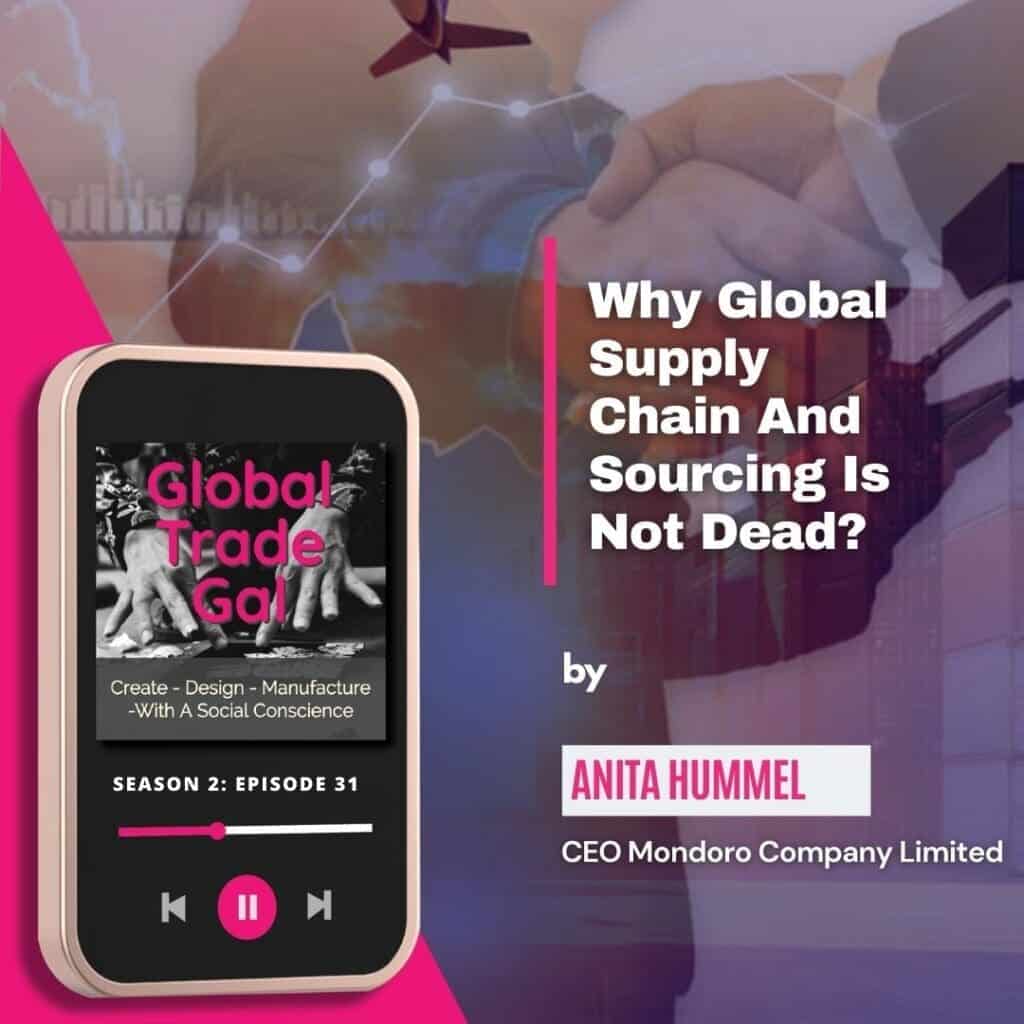I have heard some talk on the news and other places that Covid has ensured that Global Sourcing is now dead. I do not believe that Global Sourcing is still alive and well.
There are many reasons why Global Sourcing and the Global Supply Chain are not dead. Everything from the cost to selling products that other places can produce that the United States longer can. To demand the consumers for wanting to have certain types of products. The fact is to change your Global Supply Chain is expensive and takes time.
Table of Contents
- 11 Reasons Why the Global Supply Chain and Sourcing Is Not Dead
- Cost Is Cheaper Overseas
- Overseas Factories Have Invested in High-Cost Machinery
- Overseas Does Things USA Cannot.
- Labor Issues In USA And West
- Lost Art And Skills
- Demand For Certain Products
- Sustainability And Global Sourcing
- Companies Have Global Supply As Their Model
- World Is Set Up For Global Sourcing
- Global Supply Goes Two Ways
- Changing A Supply Chain Takes Time
- Related Content
11 Reasons Why the Global Supply Chain and Sourcing Is Not Dead
The global supply chain is not dead; it continues to grow and be an essential economic strategy for many companies and countries.
Here are 11 reasons why we feel like global sourcing is not dead.
Cost Is Cheaper Overseas
The primary reason people will go overseas to buy a product is because of cost. Many factories in Asia are set up to offer cost-effective products.
These Asian factories may do everything from making the frame to even the phone to sewing cushions; they may do almost everything in the house, making it cheaper than someone else to try to make it elsewhere.
I remember when I was young and I usually only had one pair of shoes because getting shoes were expensive and were pretty hard to find. But today, with the global supply chain, shoes are cheap thanks to the importation of many shoes from many parts of the world.
Overseas Factories Have Invested in High-Cost Machinery
Many of the same Asian factories have invested in some costly machinery. This machinery allows them to be far more efficient and produce the product at a cheaper cost.

Many people may be surprised when they enter a high-tech factory in Asia with the amount of equipment, machinery, and other things the factory has. I have been to some factories and seen some fantastic high-tech machinery operating in many Asian factories.
These factories can do this because of the cost advantages and the fact that they are doing considerable volume.
Overseas Does Things USA Cannot.
Many products are produced overseas that the USA can no longer have. Things such as handwoven wicker or rattan chairs. I do not know anyone in the United States during labor-intensive hand weaving. A product like this cannot efficiently be done by machine and needs to be done by hand.

Other products are lacquer or mother pearl manufacturing, which we do here in Vietnam. Again these products are incredibly labor-intensive.
Labor Issues In USA And West
I recently heard about a new trend in the United States: many young people were “quietly quitting” their jobs. In other words, they were not happy at their jobs but stayed at their jobs to get their salary but essentially quit.

It may not just be about finding people who want to work but people who can do the work. In many other parts of the world, many people are happy to do work, even challenging, because they need to feed their families.
Many parts of the world have an abundance of labor and people who want to work, so they have the workforce to get the job done where as countries like America have a labor shortage which makes producing some products complicated in the USA.

Listen To Our Podcast Why Global Supply Chain And Sourcing Is Not Dead? below or by clicking here.
Lost Art And Skills
Many products were once produced in the United States and are now only produced in other parts of the world. Many of these skills are lost in America but are no longer economical or viable to continue to make those products in the United States.
An example of this may be weaving, such as basket weaving or hand weaving. Another could be some of the hand carvings or other types of furniture manufacturing.
Demand For Certain Products
Face it – many places in the United States want to buy products that cannot be produced in the United States. This will include everything from handmade to handcrafted products.
So often, the demand, the look, a trend, or the fashion will ensure that global sourcing and trading remain essential.
One example of this that many people may not think about is almonds. When you go to China, most almonds and pistachios are produced in the United States. Overseas there is a massive demand for these types of food products.
Sustainability And Global Sourcing
Many people in the United States may be surprised to learn that many parts of Asia have been actively working on environmental and sustainability issues. Pollution and other things have become a significant factor for governments.
But not only that, many of the more giant factories know that sustainability is essential for their customers, so they have decided to monitor themselves and ensure the products they produce are sustainable. One example I recently came across was CertiPUR-US, a US certification process for foam products used in mattresses, bedding, and sofas.
Many factories we spoke with had the certification already in place as they knew it was vital for them and their US clients.
Companies Have Global Supply As Their Model
Many companies have purchased products from overseas as their primary business model. Many have profited by importing products overseas and reselling them to Big Box Stores, Amazon, or other stores.
These companies are set up to mainly buy products from overseas and sell into the United States or other western markets. They have all the processes and everything in place for global sourcing.
World Is Set Up For Global Sourcing
The world is set up for Global Sourcing; as the Internet has come about, it has become easier for companies to interact with their international counterparts. The world, in many ways, has become a smaller place.
The Internet and globalization have made the world a much smaller place. As planes become faster and the Internet becomes better, this will continue to make the world more of one place instead of an area with many borders.
Global Supply Goes Two Ways
Many in the west may not realize that the global supply goes both ways. We may buy cars from Japan and Germany, but they also purchase products from the United States.

Many industries in the United States depend upon the Global Supply Chain. I remember meeting a man with the USDA who told me that China bought many American agricultural products.
Most Americans think that China is the only one that supplies things, but I have seen many American agricultural and other food products in China.
And over the last 20+ years that I have been in China, I have seen how the Chinese taste for western food has changed. Where once you could hardly find butter cheese, now you can find it as a staple.
Changing A Supply Chain Takes Time
I think if Americans have learned anything from the Trump-era tariffs on China or some of the anti-dumping, changing a supply chain takes time. Many American companies continue to buy goods from China despite the tariffs on many products.
It is because changing a supply chain takes time. Also, having people in America reinvest in manufacturing is expensive and takes time. That is why it is pretty challenging to change your supply chain. It isn’t easy because so many variables are involved, and pieces must fit together perfectly.
I do not believe that Global Sourcing is dead. I think that Covid has exposed the world to some of the problems that a global supply chain can have, mainly when a perfect storm occurs. But gearing up or changing all your global supplies is not a very easy thing to do.
Also, as countries become more affluent, they will be willing to pay for more expensive imported products. Western countries like America, Europe, and Australia will want to be in a position where they can continue to supply the products that are cost-effective for them to produce for the rest of the world.
If you are interested in seeing how Mondoro can help you with your strategic sourcing – we would love to talk to you about how we can help you and be part of your global supply chain.
Find out more about how Mondoro can help you create, develop, and manufacture excellent home decor and furniture products – don’t hesitate to contact me, Anita. Check out my email by clicking here or become a part of our community and join our newsletter by clicking here.
Mondoro gives out a FREE Lookbook to anyone interested. You can receive a copy of our latest Lookbook by clicking here.
Listen to our Podcast called Global Trade Gal. You can find it on all major podcast platforms. Try out to listen to one of our podcasts by clicking here.
Subscribe to our Mondoro Company Limited YouTube Channel with great videos and information by clicking here.
Related Content
What Are The Major Benefits Of Strategic Sourcing?
Never underestimate the proper use of the strategic sourcing process in your supply chain. Strategic sourcing is a significant benefit to all stakeholders within the supply chain. Strategic sourcing forces all stakeholders to look at the supply chain strategy in detail. Strategic sourcing helps to eliminate any potential risks or problems.
You can discover more by reading What Are The Major Benefits Of Strategic Sourcing? by clicking here.
Seven-Step Strategic Sourcing Process Explained
A seven-step strategic sourcing strategy process will help companies be successful when looking to procure a product or a commodity. If companies take the time to go through each of the seven steps, this will help them to ensure they are successful with their sourcing needs.
You can find out more by reading our blog Seven-Step Strategic Sourcing Process Explained by clicking here.
Product Sourcing and Strategic Sourcing Explained
Product sourcing is when you source or look to find a supplier for a product you need. Strategic sourcing is strategically sourcing products. Strategic sourcing is not the lowest purchase price but the lowest overall cost. Product and strategic sourcing are very similar, but strategic sourcing is sourcing with a plan.
You can learn more by reading Product Sourcing and Strategic Sourcing Explained by clicking here.

